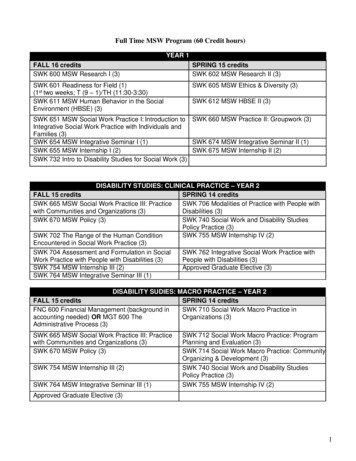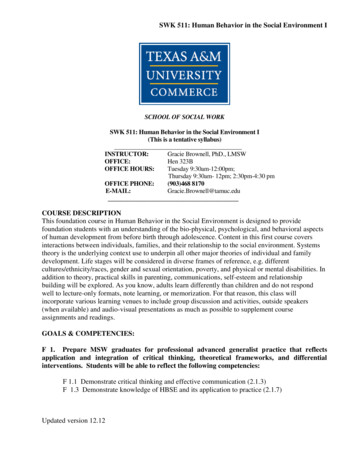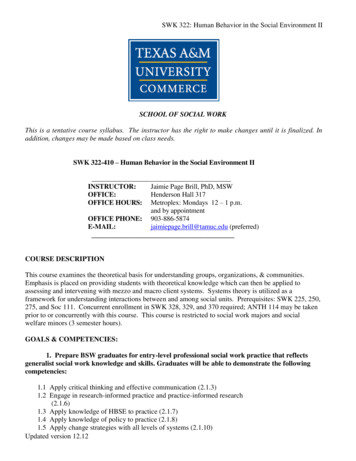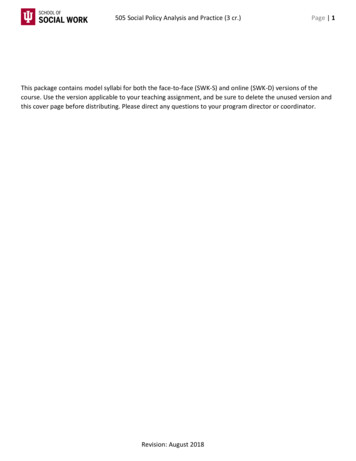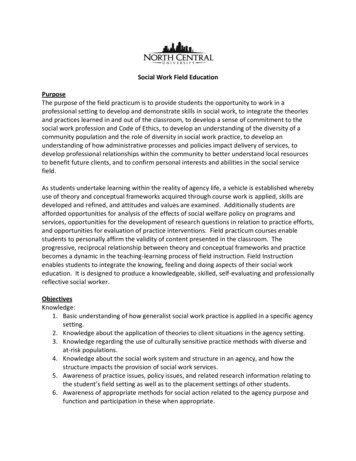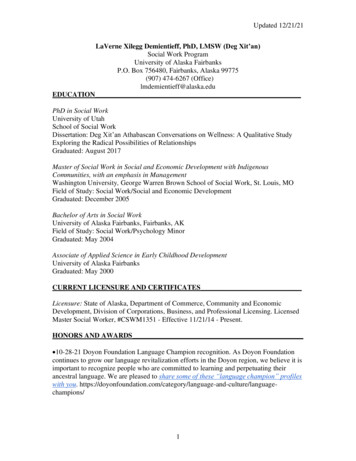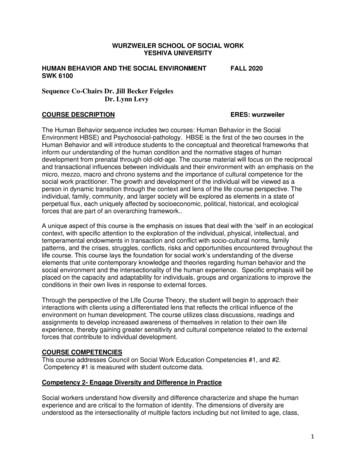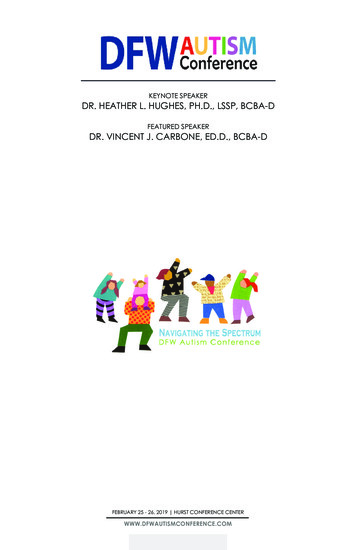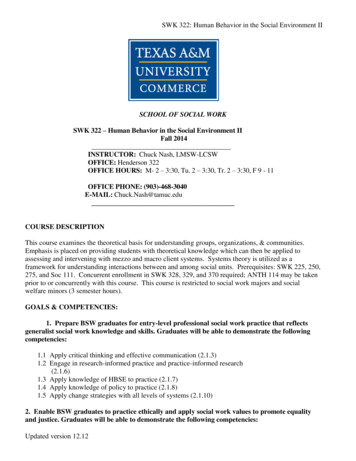
Transcription
SWK 322: Human Behavior in the Social Environment IISCHOOL OF SOCIAL WORKSWK 322 – Human Behavior in the Social Environment IIFall 2014INSTRUCTOR: Chuck Nash, LMSW-LCSWOFFICE: Henderson 322OFFICE HOURS: M- 2 – 3:30, Tu. 2 – 3:30, Tr. 2 – 3:30, F 9 - 11OFFICE PHONE: (903)-468-3040E-MAIL: Chuck.Nash@tamuc.eduCOURSE DESCRIPTIONThis course examines the theoretical basis for understanding groups, organizations, & communities.Emphasis is placed on providing students with theoretical knowledge which can then be applied toassessing and intervening with mezzo and macro client systems. Systems theory is utilized as aframework for understanding interactions between and among social units. Prerequisites: SWK 225, 250,275, and Soc 111. Concurrent enrollment in SWK 328, 329, and 370 required; ANTH 114 may be takenprior to or concurrently with this course. This course is restricted to social work majors and socialwelfare minors (3 semester hours).GOALS & COMPETENCIES:1. Prepare BSW graduates for entry-level professional social work practice that reflectsgeneralist social work knowledge and skills. Graduates will be able to demonstrate the followingcompetencies:1.1 Apply critical thinking and effective communication (2.1.3)1.2 Engage in research-informed practice and practice-informed research(2.1.6)1.3 Apply knowledge of HBSE to practice (2.1.7)1.4 Apply knowledge of policy to practice (2.1.8)1.5 Apply change strategies with all levels of systems (2.1.10)2. Enable BSW graduates to practice ethically and apply social work values to promote equalityand justice. Graduates will be able to demonstrate the following competencies:Updated version 12.12
HBSE II – FALL 20102.1 Apply social work ethics & principles (2.1.2)2.2 Engage diversity in practice (2.1.4)2.3 Promote human rights and social and economic justice (2.1.5)3. Provide meaningful contexts through which BSW students engage in leadership, service, andprofessional excellence. Graduates will be able to demonstrate the following competencies:3.1 Identify and respond as a professional social worker (2.1.1)3.2 Respond to professional contexts that shape practice,demonstrating qualities of leadership for the profession. (2.1.9)COURSE OBJECTIVES1. To reintroduce students to a systems paradigm for incorporating knowledge, theories, &methodologies for practice with groups, organizations, and communities.2. To present an overview of major theories related to groups, organizations, and communities tosupport macro practice.3. To assist students in synthesizing their understanding of social interactions within groups,organizations, and communities.4. To emphasize the impact of age, race, ethnicity, socioeconomic class, gender roles, & sexualorientation on interactions within & between groups, organizations, and communities.5. To enhance students’ awareness of social work principles, values, & ethics in relation toassessment and intervention strategies with diverse, disadvantaged, & oppressed populations ingroups, organizations, & communities.6. To assist students in analyzing the research base of theories & knowledge presented in the coursecontent to enhance their critical thinking skills.7. To encourage students’ awareness of their own attitudes & behaviors within their personal &professional environments.8. To promote knowledge of current human resource systems that is integral to the delivery of humanservices.STUDENT LEARNING OUTCOMES:RELATIONSHIP TO OTHER COURSES:TEXTSKirst-Ashman, K. (2014). Human Behavior, In the Macro Social Environment: An EmpowermentApproach to Understanding Communities, Organizations and Groups (4th Ed.). Belmont, CA:Brooks/Cole. Student addition ISBN -13: 978-1-285-07549-5Master Syllabus as of Fall 2011
HBSE II – FALL 2010GRADINGEvaluation of course grades will be assessed according to the following:In-Class AssignmentsSocial Problem PaperCommunity Group PresentationTest100 points200 points100 points100 pointsTotal: 500 pointsGrades will be determined based on the following point distribution:A 450 – 500 pointsB 400 – 449 pointsC 350 - 399 pointsD 300 -349 pointsF Below 300 pointsGrading criteria for written work include thoroughness, logical development of statements, clarityof writing, and application of readings from the course.OVERVIEW OF ASSIGNMENTS:Social Problem Paper: (200 points)This paper (8 – 10 pages) will address a specific social problem that impacts human development and/orsocial functioning and includes a major macro component. The paper is due 11/20/2014. Possible topicsinclude: UnemploymentAIDSTeenage pregnancyWorking poorHomeless families or general homelessnessPovertyDomestic violenceSexingAddictionsTextingOnce you have decided on a topic and received instructor permission; use the following as a guide tocompleting the paper:I.Using statistical data and scholarly literature, define the nature and parameters of the socialproblem and the populations most impacted by the problem, including information about thenature of the any consequences.Master Syllabus as of Fall 2011
HBSE II – FALL 2010II.Using a theoretical approach (using any theory discussed in class, i.e. systems theory), explainhow the specific social problem is created and/or maintained by the social, economic, political,media, religious and any other macro level institutions or social arrangements in our society.III.Explain the social injustices and the oppressive forces that are implicated in the problem.IV.Suggest some social work strategies for prevention of and intervention with the problem at themacro level including family, community and institutional levels.V.Papers should include at least 5 appropriate sources. Sources can include one website; the othersources must be scholarly books, chapters in books, or articles from academic journals.VI.VII.If possible, you should attend a community event/activity related to your topic. You experience atthe community event and information gleaned from the event should be included in your paper.You can include handouts or information from the community event in an appendix.Community Organization Group Presentation: (200 Points)Students will form groups of 4 or 5 and provide class presentations regarding a specific community ororganization. Group members are to work collaboratively to thoroughly assess the community ororganization, including strengths and areas of possible improvement. Students will be graded on theirindividual contribution to the final group product as well as the quality of the completed project.Individual group members who do not participate in the project will also incur a lowered project grade.Students must be present during all the class presentations to receive the points from the GroupPresentation. Presentation dates are: 11/18/2014, 11/20/2014, 11/25/2014, & 12/04/2014.Each member of the group will cover a specific element within the community or organization. Groupmembers should provide the instructor with a typed outline that includes information to be presented byeach group member. Be sure to cite sources of information presented. Group members are encouraged toinclude the following information in all presentations:A. Introduction. Include a detailed description of the community or organization.B. Assessment. Present a detailed assessment of strengths and areas in need of improvement.C. Capacity Building. Focus should be placed on how to increase the leadership and organizationalskills of people for the purpose of strengthening the community or organization. Give a briefsummary of the community’s or organization’s assets. What outside assets are available? Whatindividual and group capacities exist?D. Implications for Social Work Practice. Discuss a viable plan and implementation strategy thatwill release individual capacities and empower the community or organization. Does communityor organization empowerment include policy changes? How would a social worker form newalliances and cooperation between existing groups within the organization or agencies within thecommunity? How would social workers educate the community or organization members aboutMaster Syllabus as of Fall 2011
HBSE II – FALL 2010the plan? How will the plan be evaluated? In other words, how will the social worker empowerthe community or organization to make changes for the better?Test: (100 Points)A comprehensive test will be given which reflects content from the covered course material. The formatmay include multiple choice, true/false, short answer and essay questions. Questions may also come fromany weekly reading quizzes. The date of the exam is 12/4/2014.Class Assignments: (100 Points)These in-class exercises (approximately 10 throughout the semester) provide an opportunity to applytext/course material and will be assigned throughout the semester. These assignments will allow for thestudent to utilize creative means to demonstrate an understanding of the course content and the particulartopic assigned. Some assignments will be done individually and some will be done in a small groupformat. Instructions will be provided prior to the assignment. Students must be present during in-classexercises in order to receive the points; no make-up points will be provided.All written assignments must demonstrate acceptable writing style, American PsychologicalAssociation (APA), including the use of Standard English, acceptable grammar, and the use of theAmerican Psychological Association (APA) style of reference citation. Chapters from P Pyrczak, F., &Bruce, R. R., (2007). Writing empirical research reports (6th ed.).Glendale, CA: Pyrczak Publishing canhelp guide your writing, especially the sections on literature reviews.Part of the grading process will include an evaluation of presentation, including clarity, coherence,logic and organization of the assignment. All assignments must be typewritten, using double-spacing andstandard margins. It is the student’s responsibility to ensure the paper is in the possession of the instructorby the designated time. Any papers left in the mailbox or any other place are not the instructor’sresponsibility. All assignments must be turned in on hard copy, no electronic papers; either e-mailor disks will be accepted. At the discretion of the instructor, it may be required to submit writtenassignments via “turn-it in”, a program utilized to determine instances of plagiarism. Please follow-up toensure I have received your paper by the date assigned. Below is a partial list of factors that are addressedin the grading process: Any error in APA reference or citation format from the 7th editionLack of quotation marks at the beginning and end of all direct quotesExtra or missing punctuation (i.e. commas, semi-colons, colons, periods)Incomplete sentences (i.e., sentences without a verb)Run-on sentences (i.e., sentences that run together without appropriate punctuation andcapitalization delineating each sentence)Incorrect spellingInappropriate and inconsistent verb tenseLack of noun-verb agreementIncorrect use of capitalization (e.g., social work is generally not capitalized)Incorrect use of possessives (examples of correct use are Shawn’s book, theparents’ child)Any contractions (e.g., I’m, can’t, won’t), except in direct quotes from anotherMaster Syllabus as of Fall 2011
HBSE II – FALL 2010 source)Lack of neatness (e.g., hand written corrections, uneven indentions)Papers that are not typewrittenUse of a size other than #12 fontsLines not double spacedMargins that are less than or wider than 1 inchFailure to indent the first line of a paragraphIncoherent sentencesCLASS ATTENDANCE AND PARTICIPATION:Students are expected to attend class, reflecting responsibility which is inherent in the development as asocial work professional. Roll will be taken regularly. Students are expected to be on time and prepared toparticipate when class begins as well as be present throughout the entire class meeting. Classroomexercises, discussions, role plays, guest speakers and other in-class experiential exercises are essential fora student’s professional learning and continued development of self-awareness. Tardiness (or earlydeparture) of more than 15 minutes will count as .5 absence (2 tardies/early departures 1 absence). Astudent is considered absent if he/she arrives more than 30 minutes late to class, leaves 30 or moreminutes early or does not come to class.The following penalties for absences (unexcused, or excused, according to university policy) will beadministered:WeeklyBi-weeklySummer10-weekUp to 2 absencesNo penaltyUp to 3 absencesNo penaltyUp to 1 absenceNo penalty3 absences1 letter grade drop4 absences1 letter grade drop2 absences1 letter grade drop4 absencesClass grade of “F”5 absences1 letter grade drop3 absencesClass grade of “F”6 absencesClass grade of “F”ONLINE OR WEB-ENHANCED CLASSES: Just as students are required to attend face-to-face classes,students are required to log in and participate in online components. To receive credit for attendanceonline via eCollege, students must log in and complete assignments in a timely manner. Not logging in toeCollege (which can be monitored by the instructor) and completing assignments online during theappropriate time is the equivalent of an absence for each week this occurs.Final evaluation and grades depend on both presence and participation. Students’ grades will besignificantly impacted by inadequate participation or lack of required time commitment each week.Students are expected to spend a comparable amount of time in the online learning environment as theywould in class (3 hours a week in the classroom). In addition, just as in traditional F2F classrooms,students are expected to spend time reading and studying class materials.NOTE: PROBLEMS WITH YOUR INTERNET CONNECTION AND/OR COMPUTER ARE NOTCONSIDERED AS REASONS FOR LACK OF PARTICIPATION. You have access to the university’scomputer labs (in the social work department AND other campus facilities, including the library) as wellas local libraries and other access to computers and ISPs.Master Syllabus as of Fall 2011
HBSE II – FALL 2010If you believe that you are unable to fulfill the requirements for the course you should talk with yourinstructor about the possibility of dropping or withdrawing.Class participation has three components: (1) Appropriate interactions with classmates,(2) Attentiveness, and (3) Active involvement in class activities. Evaluation of class participation is basedon instructor observation. Students will be given feedback if problems are evident.POLICY ON DUE DATES:POLICY ON PLAGIARISM AND CHEATING:Every student is expected to do his/her own work. Law, ethical standards, university policy, anddepartmental policy demand that students refrain from plagiarism and any form of cheating. Plagiarism isthe "Act of appropriating the literacy composition of another, or parts of passages from of his [or her]writings, or the ideas or language of the same, and passing them off as the products of one's own mind."(Black's Law Dictionary, Abridged Fifth Edition, 1983). When using others' words, phrases, or ideas inwriting, the original author should be given proper credit.Cheating may take different forms. These include, but are not limited to, copying others' answers duringan exam, using notes or other forms of help during an examination or quiz, except when explicitlypermitted by the instructor, giving or receiving help on exams or assignments, or submitting work for oneclass which has already been submitted for another class for credit. Use of citations from the Internetwithout paraphrasing content AND proper referencing is regarded as plagiarism. Professors have theright to use electronic review programs (such as Turn It In”) to identify plagiarism.The department does not tolerate plagiarism or cheating. A student found to be engaging in such illegaland unethical conduct may receive a failing grade in the course and may be subjected to furtherdisciplinary proceedings. Any assignment or exam that lacks honesty will be given a grade of "0".ACCEPTABLE CLASSROOM BEHAVIOR:“Students at Texas A&M University-Commerce are expected to obey all federal, state, and locallaws, in addition to the regulations of the University. The standards of Student Conduct includingdisciplinary rules and procedures are designed to provide and conform to thebasic tenets of due process, as developed by institutions of higher education. As such, the Universitydistinguishes these procedures and regulations as an educational and growthprocess which is not intended to conform to adversary proceedings as in a court of law. (Student’s GuideBook, 2011, p. 35).CODE OF CONDUCT FOR SOCIAL WORK STUDENTSThe Department of Social Work expects all social work students to conduct themselves in an ethical,professional manner. Professional ethics are at the core of social work. The profession articulates its basicvalues, ethical principles, and ethical standards as set forth in the NASW Code of Ethics to guide socialworkers’ conduct. The Code is relevant to all social workers and social work students, regardless of theirprofessional functions, the settings in which they work, or the populations they serve. Accordingly, weMaster Syllabus as of Fall 2011
HBSE II – FALL 2010expect social work students to demonstrate courtesy, respect and support for fellow students, instructors,clients, and all other persons.All students enrolled in BSW or MSW classes are expected to observe the tenets of the NASW Code ofEthics and the Social Work Student Code of Conduct. Our Code of Conduct is reflective of professionaland academic expectations – a student who cannot demonstrate appropriate behaviors will not beappropriate for practice in the social work profession. Students who violate these Codes may be asked tomeet with appropriate Social Work faculty (instructors or Program Directors). In addition, thedepartment’s Academic and Professional Issues (API) Committee is responsible for dealing with studentissues when requested by faculty.STUDENTS WITH DISABILITIESIt is the policy of Texas A&M University-Commerce and the Social Work Department to do everythingwe can to accommodate students with disabilities, pursuant to federal and state law, and the University’scommitment to providing equal opportunities. Any student with a disability who needs accommodation,for example, in accessibility, seating placement or in arrangements for examinations should not hesitate toinform the instructor. If required, large type, Braille or cassette recordings of syllabus or assignments canbe provided.Students with conditions that require special attention or accommodation should contact the Director ofDisability Resources & Services at 903-468-5150 (located in the Library, Room 132).Master Syllabus as of Fall 2011
HBSE II – FALL 2010COURSE SCHEDULEWeekReading(s)Assignment/ActivitiesLink to Comp.SLO1Aug26/282Sep9/113Sep16/184Sep23/2526 Introductions andgroup assignment. 28 Ch 19 BSW ASSEMBLY10-111 Ch 216 Ch 318 Ch 4Please read all chapters priorto coming to class. You willbe gradedReview of the NASW Codeof Ethics p. 51 Exercise.EP 2.1.7,2.1.1c,2.1.22.1.6.2.1.3.2.1.3a1 -8Reading/LectureEP2.1.10a2.1.4a. 2.1.7a 2.1.4c.2.1.1d1-823 Ch 525 Ch 5EP2.1.7. 2.1.7a.b. 2.1.10a. 2.1.31 -85Sep/Oct30/76Oct9/147Oct 16Oct. 218Oct23/289Oct 30Nov 410Nov6/1111Nov13/1812Nov20/2530 Ch 67 follow up readingsReading/LectureEach Student bring the nameofTwo organizations to classReadings/lectureEP2.1.7. 2.1.7a,b2.1.4.2.1.10f1-89 Ch 714 Ch 7Building a diagram of anagency in classEP2.1.7. 2.1.7a,b2.1.10 B2.21-816 Ch 8Readings/Lecture2.1.7. 2.1.7. a,b. 2.1.1c,d.2.1.31–8Readings and review forcomm. b2.1.4.a. 2.1.4c.2.1.31-8EP 2.1.71-86 Ch 1211 Ch 13Reading/VideoEP2.1.7a/b.2.1.4.2.1.10e,g,j 1 - 813 Summarize18 PresentationDiscussions/PresentationClass Group Presentations20 PresentationSOCIAL PROBLEMPAPER DUE25 Presentation2 presentation4 FINAL EXAMClass Group Presentation13Dec 2/421 Ch 923/28 Ch 1030/4 Ch 1114Master Syllabus as of Fall 2011Class PresentationFINAL EXAMEP 2.1.2b.c.d. 2.1.4. 2.1.4c. 1 – 82.1.3. 2.1.10e
HBSE II – FALL 20101516BIBLIOGRAPHYBeckett, J., & Johnson, H. Human development. In Encyclopedia of Social Work, 19th edition,vol. 3, pp. 1385-1405. Washington: National Association of Social Workers.Chaskin, R. (1997). Perspectives on Neighborhood and Community: A Review of the Literature.Social Service Review, 71(4), 521-548.Coulton, C.J. (2003). Metropolitan Inequities and the Ecology of Work: Implications forWelfare Reform. Social Service Review, 159-190.Cowger, C. & Snively, C. (2002). Assessing client strengths: Individual, family, and communityempowerment. In D. Saleeby, (Ed.), The strengths perspective in social workpractice. New York: Longman Press, Ch. 7.Fellin, P. (2001). The Community and the Social Worker (3rd Ed.). Itasca, IL: Peacock.Gladwell, M. (2000). The tipping point: How little things can make a big difference. NewYork: Little, Brown. Ch. 1.Graham, E., & Boyce, J. (1995). A south Bronx street rises through the toil of poorhomesteaders. In P. Fellin (Ed.), The Community and the Social Worker (2nd Ed.) (pp. 91-95).Itasca, IL: Peacock Publishers.Hardina, D. (2003). Linking citizen participation to empowerment practice: A historicaloverview. Journal of Community Practice, 11(4), 11-38.Halpern, R. (1995). Neighborhood-based services in low-income neighborhoods: A briefhistory. In P. Adams & K. Nelson (Eds.), Reinventing Human Services: Community and FamilyCentered Practice. New York: Aldine de Gruyter, 19-40.Hills, D. (1998). Engaging new social movements. Human Relations, 51, 1457-1475.Master Syllabus as of Fall 2011
HBSE II – FALL 2010Hutchison, E. D. (2003). Social movements. In Hutchison, E. D. (Ed.), Dimensions of humanbehavior, 2nd ed., pp. 542-571. Thousand Oaks, CA: Sage Publications.Jasper, J. M. (1997). The art of moral protest: Culture, biography, and creativity in socialmovements. Chicago: University of Chicago Press., ch. 2: The classical paradigms.McPherson, M., Smith-Lovin, L., & Cook, J.M. (2001). Birds of a feather: Homophily in socialnetworks. Annual Review of Psychology, 27, 415-444.Miller, J.M., & Schamess, G. (2000). The discourse of denigration and the creation of “other.”Journal of Sociology and Social Welfare, 27, 39-62.Mills, C. W. (1956). The power elite. New York: Oxford. Ch 12: The power elite.Mullaly, R. (1997). Structural Social Work: Ideology, Theory, and Practice (2nd Ed.). Toronto:Oxford University Press. Ch. 8.O’Melia, M. and Miley, K.K. (2002). Pathways to Power: Readings in Contextual Social WorkPractice. Boston: Allyn & Bacon.Penner, L. A., Dovidio, J. F., Piliavin, J. A., & Schroeder, D. A. (2005). Prosocialbehavior: Multilevel perspectives. Annual Review of Psychology, 56(1), 365-393Putnam, R. (2000). Bowling alone: The collapse and revival of American community. New York:Simon & Schuster. Chs. 1, 15, and 24.Rank, M. G. & Hutchison, W. S. (2000). An analysis of leadership within the social workprofession. Journal of Social Work Education, 36, 487-502.Rivera, F. G. and J. L. Erlich. 1995. Organizing with People of Color: A Perspective. In J.Tropman, et al., Tactics and Techniques of Community Intervention (3rd ed.). Itasca, IL: Peacock,198-214.Rubin, H.J. & Rubin, I.S. (2001). Community Organizing & Development. Boston: Allyn &Bacon.Master Syllabus as of Fall 2011
HBSE II – FALL 2010Specht, H. & Courtney, M. (1994). Unfaithful angels: How social work has abandoned itsmission. New York: The Free Press.Venkatesh, S.A. (1997). The three-tier model: How helping occurs in urban, poorcommunities. Social Service Review, 574-606.Wakefield, J.C. (1996). Does social work need the eco-systems perspective: Part 2. Does theperspective save social work from incoherence? Social Service Review, 70, 183-213.Warren, K., Franklin, C., & Streeter, C. L. (1998). New directions in systems theory: Chaos andcomplexity. Social Work, 43, 357-372.Wellman, B. & Wortley, S. (1990). Different Strokes from Different Folks: Community Tiesand Social Support. American Journal of Sociology, 96(3), 558-588.Master Syllabus as of Fall 2011
8. To promote knowledge of current human resource systems that is integral to the delivery of human services. STUDENT LEARNING OUTCOMES: RELATIONSHIP TO OTHER COURSES: TEXTS Kirst-Ashman, K. (2014). Human Behavior, In the Macro Social Environment: An Empowerment Approach to Understanding Communities, Organizations and Groups (4th Ed.).
